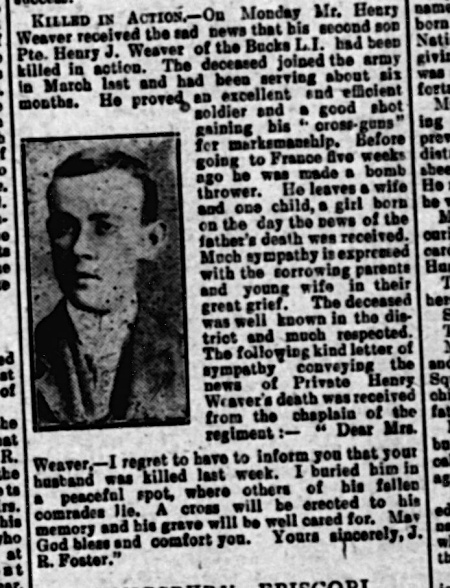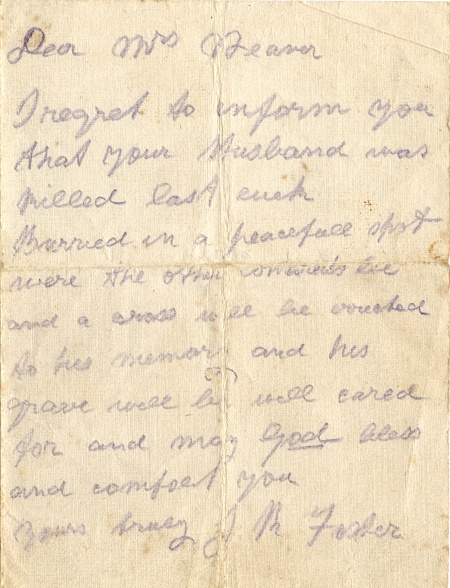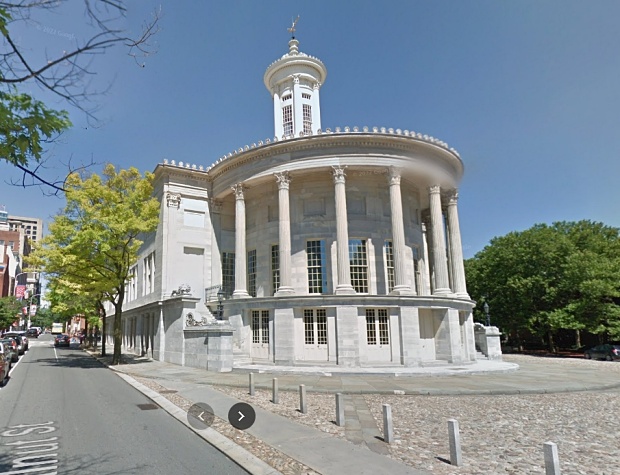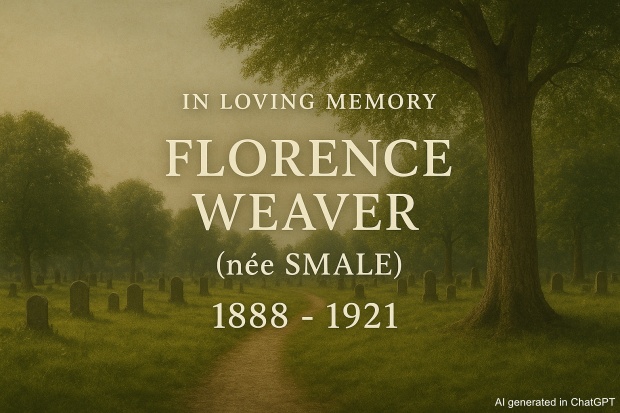ON THIS DAY… 8TH SEPTEMBER
I’ve relayed the story of my great-grandfather, Henry James Weaver, many times whenever the anniversary of his death comes around. But recently, a newspaper clipping reminded me of something I hadn’t considered before – when Henry was killed, he didn’t just leave behind a widow and an unborn child. His parents, too, were mourning the loss of their second son.
The following notice appeared in the Langport & Somerton Herald on Saturday, 23 September 1916:
KILLED IN ACTION.– On Monday Mr. Henry Weaver received the sad news that his second son Pte. Henry J. Weaver of the Bucks L.I. had been killed in action. The deceased joined the army in March last and had been serving about six months. He proved an excellent and efficient soldier and a good shot gaining his “cross-guns” for marksmanship. Before going to France five weeks ago he was made a bomb thrower. He leaves a wife and one child, a girl born on the day the news of the father’s death was received. Much sympathy is expressed with the sorrowing parents and young wife in their great grief. The deceased was well known in the district and much respected. The following kind letter of sympathy conveying the news of Private Henry Weaver’s death was received from the chaplain of the regiment:- “Dear Mrs. Weaver, – I regret to have to inform you that your husband was killed last week. I buried him in a peaceful spot, where others of his fallen comrades lie. A cross will be erected to his memory and his grave will be well cared for. May God bless and comfort you. Yours sincerely, J. R. Foster.”

Langport & Somerton Herald – Saturday 23rd September 1916
Florence and the Timing of the News
Henry’s widow, Florence, was living with her parents in Tavistock, Devon, when he was killed on 8th September 1916. The newspaper reported that Henry’s parents (William Henry Weaver & Jane, née Arnold) in Curry Rivel, Somerset, received the news on the Monday prior to publication, which was the 18th September 1916 – the very day my gran was born. According to family legend, Florence wasn’t told the news for another ten days, likely because she was recovering from childbirth.
It may be that Henry’s parents received an official telegram or perhaps Florence’s parents, William Henry and Grace Smale, sent a telegram to Somerset, and later followed up with a letter that included a copy of the chaplain’s words. This would explain how the Langport Herald was able to publish the story so quickly, just five days later.
A family member still holds the original letter written by J. R. Foster. Until I saw this notice, I hadn’t realised he was the regiment’s chaplain. Interestingly, the wording in the original differs slightly from the version printed in the newspaper.

Letter from The Chaplain of the Regiment
Details Confirmed and New Insights
The article confirmed some facts I’d already known and helped to substantiate and expand on others:
Marksmanship: I knew Henry was a skilled shot, as the family still holds a silver teaspoon which he was awarded in 1914 by the North Cadbury Miniature Rifle Club. The inscription reads:
“N. Cadbury.
Miniature Rifle Club.
–1914–
February – H. Weaver.
Monthly Spoon.”
(view the spoon here.)
Army Service: I’d previously assumed Henry was conscripted, but the article says he joined the army in March 1916. While single men were “deemed to have enlisted” on 2nd March 1916, conscription for married men didn’t begin until later that year. Henry married in 1915 so he must have been a volunteer.
France: The article notes he went to France “five weeks ago,” which places his deployment around 19th August 1916. This aligns with Henry’s surviving letters. One, written from France on 25th August 1916 shortly after his arrival, fits the timeline perfectly.
The Date Of The News: My gran had always understood that the news of her father’s death arrived on the day she was born. The newspaper confirms this heartbreaking detail.
Bomb Thrower: I knew Henry had been killed by accident when a bomb (hand grenade) prematurely detonated during training at the base, but I hadn’t appreciated until now that he’d actually been assigned as a bomb thrower shortly before deployment. In the early years of the First World War, British soldiers improvised with jam-tin grenades but, by 1916, they were issued with Mills bombs. These grenades were powerful but unpredictable and bomb throwers faced enormous risks even before reaching the front line. The fact that Henry’s life ended this way underscores the harsh reality that danger for WWI soldiers was not confined to the trenches. He died alongside two others.
Closing Reflections
The cruel timing of events in September 1916 bound my gran’s birth and her father’s death together. Henry was killed on 8th September, yet the news didn’t reach his parents or his wife’s family until the 18th – the very day Florence gave birth. For Florence, the shattering reality of widowhood came a little later when she was finally told that Henry would never return.
Henry’s story is one of quiet bravery and deep loss. He was respected in his community, loved by his family and remembered with honour. Each new detail, whether from a newspaper clipping or a family keepsake, adds depth to the legacy he left behind.











